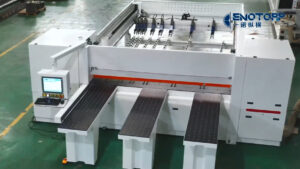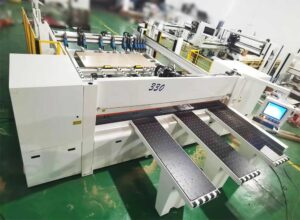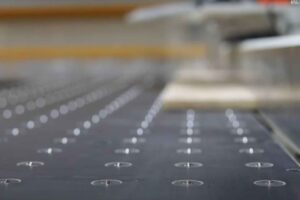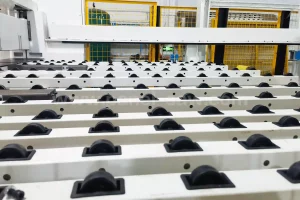
Effective Techniques for Cutting Complex Shapes with a Computer Panel Saw Operator
As a Computer Panel Saw operator, one of the most challenging tasks is cutting complex shapes with precision and accuracy. With the advancement of technology, Computer Panel Saws have become an essential tool in various industries, including furniture making, construction, and manufacturing. However, cutting complex shapes requires a combination of skill, knowledge, and the right techniques. In this article, we will explore effective techniques for cutting complex shapes with a Computer Panel Saw, ensuring that you achieve the desired results with minimal errors.
Understanding the Capabilities and Limitations of Your Computer Panel Saw
First and foremost, it is essential for computer panel saw operators to understand the capabilities and limitations of their Computer Panel Saw. Familiarize yourself with the machine’s specifications, including the type of saw blade, cutting depth, and speed. This knowledge will enable you to plan your cutting process effectively and avoid any potential issues. Additionally, ensure that your saw is properly maintained and calibrated to ensure accurate cutting.
Knowing the machine’s specifications helps computer panel saw operators to determine the optimal settings for each task. The type of saw blade, for instance, plays a crucial role in the quality of the cut. High-tooth-per-inch (TPI) blades are excellent for intricate cuts, while low-TPI blades are better suited for cutting thicker materials. Understanding these details will help you choose the right blade for your project.
Regular maintenance and calibration are also vital. A well-maintained Computer Panel Saw ensures consistent performance and minimizes the risk of errors. Calibration ensures that the saw cuts precisely according to the specifications, which is especially important when dealing with complex shapes.
In conclusion, understanding the capabilities and limitations of your Computer Panel Saw is the first step toward successful operation. By familiarizing yourself with the machine’s specifications and ensuring proper maintenance and calibration, computer panel saw operators can achieve precise and accurate cuts.
Creating a Detailed Cutting Plan as Computer Panel Saw Operators
When cutting complex shapes, it is crucial for computer panel saw operators to start with a solid understanding of the design. Study the design carefully, taking note of any intricate details, curves, and angles. This will help you to identify potential challenges and plan your cutting process accordingly. It is also essential to create a detailed cutting plan, including the sequence of cuts, cutting direction, and any necessary adjustments.
A detailed cutting plan acts as a roadmap for the cutting process. By breaking down the design into manageable sections, computer panel saw operators can approach each part of the cut with confidence. This reduces the likelihood of mistakes and ensures a smoother workflow.
In addition to planning the sequence of cuts, consider the cutting direction. The direction can affect the quality of the cut and the wear on the blade. For instance, cutting with the grain of the wood can result in a cleaner cut compared to cutting against the grain. Also, plan for any necessary adjustments during the cutting process. This might include changes to the cutting depth or angle to accommodate different parts of the design.
In conclusion, creating a detailed cutting plan is essential for computer panel saw operators. By thoroughly understanding the design and planning the sequence of cuts and necessary adjustments, operators can achieve precise and accurate results.
Selecting the Right Saw Blade and Adjusting Cutting Speeds
Another critical aspect of cutting complex shapes is the selection of the right saw blade. The type of saw blade you choose will depend on the material you are cutting, the complexity of the shape, and the desired finish. For example, a high-tooth-per-inch (TPI) saw blade is ideal for cutting intricate curves and details, while a low-TPI saw blade is better suited for cutting thicker materials.
Once you have selected the right saw blade, it is time to start cutting. Begin by making a series of small, controlled cuts, gradually working your way through the design. Use a combination of slow and fast cutting speeds to achieve the desired results. For example, you may need to use a slower speed to cut through thicker materials and a faster speed to cut through thinner materials.
Adjusting the cutting speed according to the material and complexity of the cut is crucial for achieving high-quality results. Slower speeds provide more control and precision, which is essential for intricate designs. Faster speeds, on the other hand, are suitable for straight cuts or less complex shapes where precision is not as critical.
Computer panel saw operators should also monitor the saw’s performance during cutting. Listen for any unusual noises and watch for excessive vibration, which can indicate that the saw is not performing optimally. Make any necessary adjustments to the saw’s angle, depth, or speed to maintain accuracy and control.
In conclusion, selecting the right saw blade and adjusting cutting speeds are critical for computer panel saw operators. By choosing the appropriate blade and adjusting speeds based on material and design complexity, operators can achieve precise and accurate cuts.
Monitoring Material Properties and Computer Panel Saw Operators Inspecting Cuts
In addition to the saw itself, the cutting process is also influenced by the material being cut. Different materials have unique properties that can affect the cutting process. For example, some materials may be prone to warping or cracking, while others may be more difficult to cut through. Understanding the properties of the material you are cutting will enable you to adjust your cutting technique accordingly.
Computer panel saw operators should be aware of how different materials behave during cutting. For instance, cutting MDF might produce more dust compared to cutting plywood, which requires appropriate dust extraction systems to maintain a clean work environment. Similarly, cutting hardwoods might require different blade settings compared to cutting softwoods to prevent burning or chipping.
Finally, it is essential for computer panel saw operators to inspect their cuts carefully, checking for any errors or imperfections. Use a combination of visual inspection and measurement tools to ensure that your cuts are accurate and precise. If necessary, make any necessary adjustments to the saw or the cutting process to achieve the desired results.
Regular inspection ensures that any mistakes are caught early and can be corrected before they affect the entire project. Using measurement tools such as calipers or rulers can help verify the accuracy of the cuts. If any adjustments are needed, they should be made immediately to maintain the quality and consistency of the work.
In conclusion, monitoring material properties and inspecting cuts are vital for computer panel saw operators. By understanding how different materials behave and carefully inspecting each cut, operators can ensure high-quality results and minimize errors.
Conclusion: Mastering Complex Cuts with a Computer Panel Saw
In conclusion, cutting complex shapes with a Computer Panel Saw requires a combination of skill, knowledge, and the right techniques. By understanding the capabilities and limitations of the saw, creating a detailed cutting plan, selecting the right saw blade, adjusting cutting speeds, and monitoring material properties, computer panel saw operators can achieve precise and accurate cuts. Additionally, careful inspection of cuts ensures high-quality results and minimizes errors. With practice and patience, computer panel saw operators can become proficient in cutting complex shapes, enabling them to produce high-quality products with precision and accuracy.
Summary
The article provides comprehensive guidance for computer panel saw operators on cutting complex shapes with precision and accuracy. Key techniques include understanding the saw’s capabilities and limitations, creating a detailed cutting plan, selecting the right saw blade, adjusting cutting speeds, and monitoring material properties. Regular inspection of cuts is also emphasized to ensure high-quality results. By following these techniques, operators can achieve precise cuts and minimize errors, enhancing productivity and product quality.
FAQ
Q: What are the first steps for computer panel saw operators to ensure successful cuts? A: The first steps include understanding the saw’s capabilities and limitations, such as the type of saw blade, cutting depth, and speed, as well as ensuring the saw is properly maintained and calibrated.
Q: How important is creating a detailed cutting plan for computer panel saw operators? A: Creating a detailed cutting plan is crucial as it helps operators understand the design, plan the sequence of cuts, and identify potential challenges, ensuring precise and accurate results.
Q: What factors should computer panel saw operators consider when selecting a saw blade? A: Operators should consider the material being cut, the complexity of the shape, and the desired finish. High-TPI blades are ideal for intricate cuts, while low-TPI blades are better for thicker materials.
Q: How do cutting speeds affect the quality of cuts for computer panel saw operators? A: Adjusting cutting speeds based on the material and complexity of the cut is essential. Slower speeds provide more control for intricate designs, while faster speeds are suitable for less complex cuts.
Q: Why is it important for computer panel saw operators to monitor material properties? A: Different materials have unique properties that affect the cutting process. Understanding these properties helps operators adjust their technique to prevent issues like warping or cracking.
Q: What tools can computer panel saw operators use to inspect cuts for accuracy? A: Operators can use visual inspection and measurement tools such as calipers or rulers to ensure cuts are accurate and precise. Regular inspection helps catch and correct errors early.
Q: How does understanding the saw’s limitations benefit computer panel saw operators? A: Knowing the saw’s limitations helps operators avoid overloading the machine and ensures they use the saw within its optimal parameters, preventing mechanical failures and maintaining safety.
Q: What role does practice and patience play for computer panel saw operators? A: Practice and patience are essential for mastering the techniques required for cutting complex shapes. Consistent practice helps operators refine their skills and achieve high-quality results.
Q: How can computer panel saw operators maintain a clean work environment? A: Operators should use appropriate dust extraction systems and regularly clean the workspace to prevent dust and debris from affecting the cutting process and machine performance.
Q: Why is regular maintenance important for computer panel saw operators? A: Regular maintenance ensures the saw operates efficiently and reduces the risk of errors. It also extends the machine’s lifespan and reliability, ensuring consistent performance.



